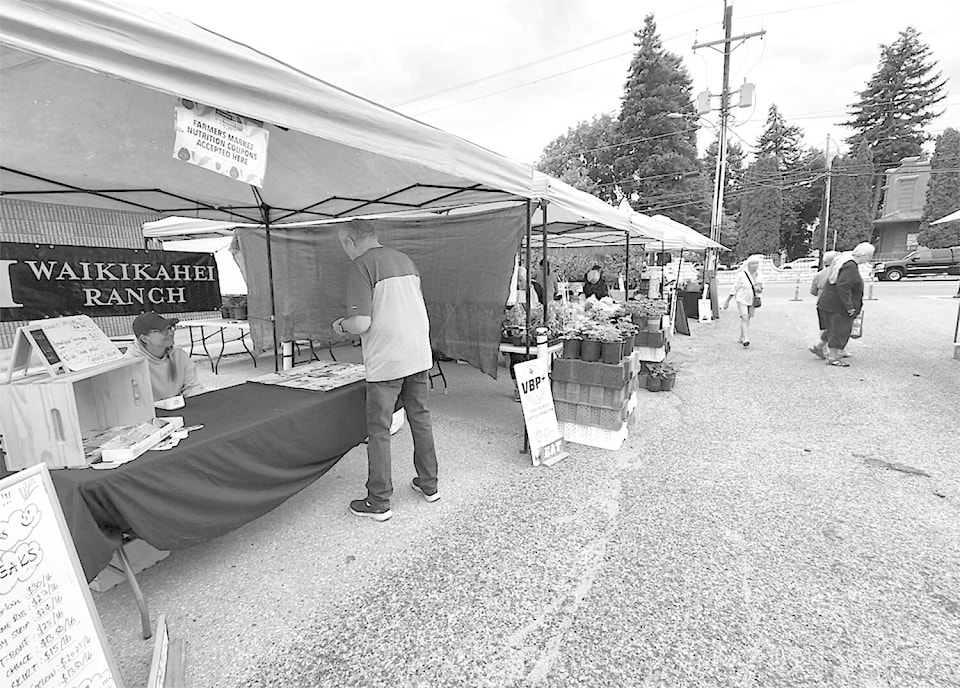The Grand Forks Farmers Market is having a large impact on the local economy, according to the findings of a survey conducted last summer.
The BC Association of Farmers’ Markets (BCAFM) conducted a study on the economic impacts of markets across BC, including the Grand Forks Farmers’ Market, specifically the summer outdoor market, which runs from May to October.
A survey and research into the economic impact conducted Tuesday, July 18th, 2023 was released March 13 of this year and revealed several key points:
- The market had a $2.1 million annual economic impact on the local economy.
- Annual direct sales at this market were $1.4 million
- The average shopper at this market spends about $32.68 per visit
- The market experiences more than 57,000 visits and 42,800 shoppers annually
- 42 per cent of the survey respondents visited the market either regularly (almost weekly) or frequently (two-to-three times per month)
For the first point, the study findings pointed out this is a measure of the “ripple effect” for every dollar spent at farmers’ markets, including money vendors spend on inputs for the products sold.
This survey was part of a larger study project conducted in partnership with Dr. David Connell at the University of Northern British Columbia, BCAFM and the Sustainable Canadian Agricultural Partnership.
Calling the study results “impressive,” Heather O’Hara, Executive Director of BCAFM, said these findings show how much the Grand Forks Farmers’ Market is a major contributor in the local economy.
“This lets us aggregate the study and show a snapshot of Grand Forks added to over 100 other markets to show $233 million in economic impact,” she said. “So as a sector, it’s really valuable. And sometimes people don’t realize the numbers are that high and how much economic activity happens at the local market.”
These markets are more than sales and directing traffic to other businesses, they are also incubators of business and entrepreneurship. Markets often serve as a starting point, or another outlet, for local businesses to have an affordable way to sell products directly without having to invest in a physical storefront. It’s also a great way for farms and smaller agricultural producers to sell their products without having to compete with larger producers or try to secure shelf space in supermarkets.
The BCAFM has sponsored three studies on markets because it wants to update its data and observations of the growth of markets. O’Hara said the changing trends and increasing support shows farmer’s markets matter to the public and the province’s economy.
“It shows that these markets matter in all kinds of communities in the province, no matter the size,” she said. “Whether it’s the City of Vancouver, Grand Forks or the Columbia Basin Region, Revelstoke, Prince George, they make a big difference in farm and food businesses and local economies.”
Grand Forks Farmers’ Market treasurer Sharon St. Onge agreed that they are getting great support from the community and city administration, as well as it helps support and invest in small local farms.
“It allows us to work our crops, buy our seed, employ staff and pay our bills for the winter,” she said. “We have a lot of new people coming to sell at the market. They are not new to town, per se, but new to farming and artisan business and are here because of what they’ve seen happening at the market.”
It also helps support the community through programs like food vouchers for families and nutrition programs, allowing people to access nutritious, locally made food they likely couldn’t afford.
Grand Forks was just one of several markets that were surveyed in the province last summer. In all, direct sales at these farmers’ markets were $155 million or 2023, contributing to $233 million in overall economic impact for the provincial economy, the study results revealed.
The method was called a “dot survey,” where people were asked to place dots on a whiteboard with specific questions about their shopping habits. Respondents were separated into local shoppers and tourist shoppers.
The questions were:
1. How much have you spent, or do you plan to spend, at the market today?
2. How often do you come to this farmers market?
3. If you plan to do additional shopping or eating while in this area of town today, how much do you plan to spend?
4. When did you start shopping at this market?
5. What is your primary reason why you came to the farmers’ market today?
People were also asked to be interviewed on their shopping habits and reasons for coming to the market, how much they spent and if they visited other businesses in the area while at the market. Neighbouring businesses were also surveyed on the economic impacts of the market.
Survey team members also stood at entry points of the market for 10 minutes at every hour to count people entering. The total number of people coming to the market was assessed with this systematic counting method. Project team members then used an established formula of multiplying the actual counts by six to determine estimated hourly attendance. Using this method, it was calculated that around 215 people per hour came to the market. The provincial average is 377 per hour.
The 2023 survey and study project builds upon similar projects completed in 2012 and 2006, which were also led by BCAFM and Connell, O’Hara said. Project coordinators were able to assess changes in shopping habits and economic impacts over time using data from all three projects. In total, 70 farmers’ markets were surveyed between May and September of last year.
